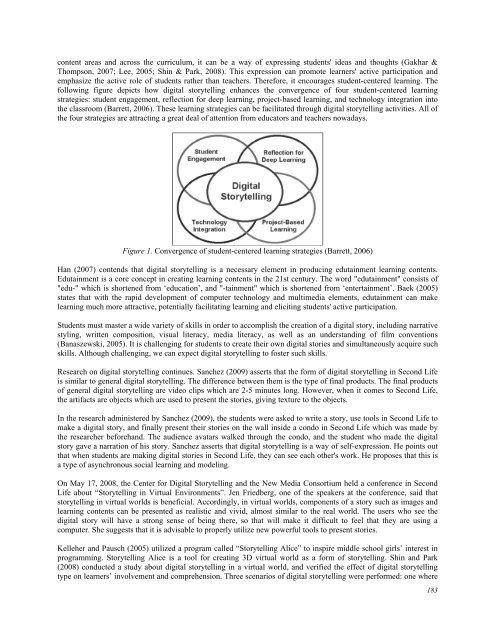October 2011 Volume 14 Number 4 - Educational Technology ...
October 2011 Volume 14 Number 4 - Educational Technology ...
October 2011 Volume 14 Number 4 - Educational Technology ...
You also want an ePaper? Increase the reach of your titles
YUMPU automatically turns print PDFs into web optimized ePapers that Google loves.
content areas and across the curriculum, it can be a way of expressing students' ideas and thoughts (Gakhar &<br />
Thompson, 2007; Lee, 2005; Shin & Park, 2008). This expression can promote learners' active participation and<br />
emphasize the active role of students rather than teachers. Therefore, it encourages student-centered learning. The<br />
following figure depicts how digital storytelling enhances the convergence of four student-centered learning<br />
strategies: student engagement, reflection for deep learning, project-based learning, and technology integration into<br />
the classroom (Barrett, 2006). These learning strategies can be facilitated through digital storytelling activities. All of<br />
the four strategies are attracting a great deal of attention from educators and teachers nowadays.<br />
Figure 1. Convergence of student-centered learning strategies (Barrett, 2006)<br />
Han (2007) contends that digital storytelling is a necessary element in producing edutainment learning contents.<br />
Edutainment is a core concept in creating learning contents in the 21st century. The word "edutainment" consists of<br />
"edu-" which is shortened from ‘education’, and "-tainment" which is shortened from ‘entertainment’. Baek (2005)<br />
states that with the rapid development of computer technology and multimedia elements, edutainment can make<br />
learning much more attractive, potentially facilitating learning and eliciting students' active participation.<br />
Students must master a wide variety of skills in order to accomplish the creation of a digital story, including narrative<br />
styling, written composition, visual literacy, media literacy, as well as an understanding of film conventions<br />
(Banaszewski, 2005). It is challenging for students to create their own digital stories and simultaneously acquire such<br />
skills. Although challenging, we can expect digital storytelling to foster such skills.<br />
Research on digital storytelling continues. Sanchez (2009) asserts that the form of digital storytelling in Second Life<br />
is similar to general digital storytelling. The difference between them is the type of final products. The final products<br />
of general digital storytelling are video clips which are 2-5 minutes long. However, when it comes to Second Life,<br />
the artifacts are objects which are used to present the stories, giving texture to the objects.<br />
In the research administered by Sanchez (2009), the students were asked to write a story, use tools in Second Life to<br />
make a digital story, and finally present their stories on the wall inside a condo in Second Life which was made by<br />
the researcher beforehand. The audience avatars walked through the condo, and the student who made the digital<br />
story gave a narration of his story. Sanchez asserts that digital storytelling is a way of self-expression. He points out<br />
that when students are making digital stories in Second Life, they can see each other's work. He proposes that this is<br />
a type of asynchronous social learning and modeling.<br />
On May 17, 2008, the Center for Digital Storytelling and the New Media Consortium held a conference in Second<br />
Life about “Storytelling in Virtual Environments”. Jen Friedberg, one of the speakers at the conference, said that<br />
storytelling in virtual worlds is beneficial. Accordingly, in virtual worlds, components of a story such as images and<br />
learning contents can be presented as realistic and vivid, almost similar to the real world. The users who see the<br />
digital story will have a strong sense of being there, so that will make it difficult to feel that they are using a<br />
computer. She suggests that it is advisable to properly utilize new powerful tools to present stories.<br />
Kelleher and Pausch (2005) utilized a program called “Storytelling Alice” to inspire middle school girls’ interest in<br />
programming. Storytelling Alice is a tool for creating 3D virtual world as a form of storytelling. Shin and Park<br />
(2008) conducted a study about digital storytelling in a virtual world, and verified the effect of digital storytelling<br />
type on learners’ involvement and comprehension. Three scenarios of digital storytelling were performed: one where<br />
183

















